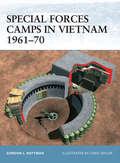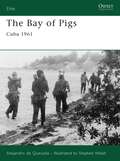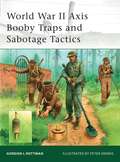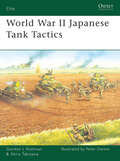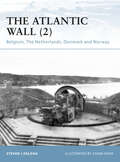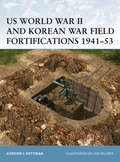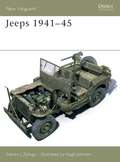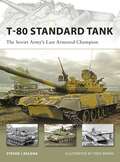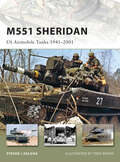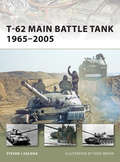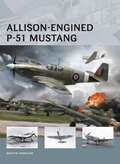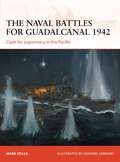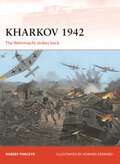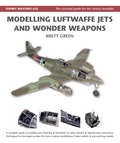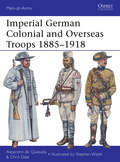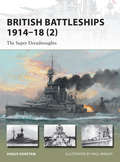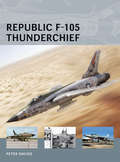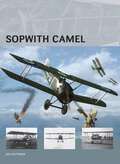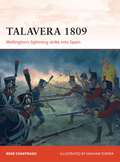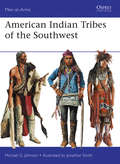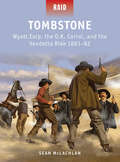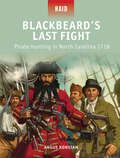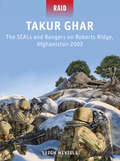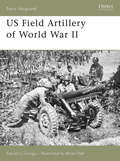- Table View
- List View
Special Forces Camps in Vietnam 1961-70
by Gordon RottmanIn 1961 US Special Forces units began entering remote areas of Vietnam dominated by the Viet Cong. Their task was to organize local defense and strike forces aimed at stopping the enemy from gaining further control of such areas. The Green Berets set up fortified camps from which indigenous troops defended local villages and attacked and harassed the enemy. How these camps were constructed, developed, and defended is documented here for the first time. This book also covers the weapons, barriers, and obstacles used in these camps, providing specific examples of camp design, and details how they withstood the test of battle against a determined and resourceful enemy.From the Trade Paperback edition.
Confederate Ironclad vs Union Ironclad
by Howard Gerrard Ron FieldThe Ironclad was a revolutionary weapon of war. Although iron was used for protection in the Far East during the 16th century, it was the 19th century and the American Civil War that heralded the first modern armored self-propelled warships. With the parallel pressures of civil war and the industrial revolution, technology advanced at a breakneck speed. It was the South who first utilized ironclads as they attempted to protect their ports from the Northern blockade. Impressed with their superior resistance to fire and their ability to ram vulnerable wooden ships, the North began to develop its own rival fleet of ironclads. Eventually these two products of this first modern arms race dueled at the battle of Hampton Roads in a clash that would change the face of naval warfare. Fully illustrated with cutting-edge digital artwork, rare photographs and first-person perspective gun sight views, this book allows the reader to discover the revolutionary and radically different designs of the two rival Ironclads - the CSS Virginia and USS Monitor - through an analysis of each ship's weaponry, ammunition and steerage. Compare the contrasting training of the crews and re-live the horrors of the battle at sea in a war which split a nation, communities and even families.From the Trade Paperback edition.
The Bay of Pigs
by Stephen Walsh Alejandro QuesadaOsprey's examination of the events in the Bay of Pigs (1961) that led to the Cuban Missile Crisis (1962). In early 1961 President John F. Kennedy gave the go-ahead to an existing plan for Cuban exiles to return to overthrow Fidel Castro's communist regime. While the CIA helped in the planning stages, the attempt would not be assisted by any US armed forces. On the night of April 16, 1961, a force of 1,400 exiles, known as 2506 Brigade, landed at the Bay of Pigs on the south coast of Cuba, supported by a few World War II vintage aircraft flying from Nicaragua. While they succeeded in knocking out some of Castro's small air force on the ground, the remaining Cuban aircraft sank two of the exiles' support ships, and the beachhead became isolated. Fighting continued for three days before Castro's army overwhelmed the landing force. Most of the exiles were captured and suffered a harsh imprisonment before the US negotiated their release. This episode, followed by the installation of Soviet missiles in Cuba, led directly to the Cuban Missile Crisis of October 1962, and continues to affect US/Cuban diplomatic relations to this day. This book, written by the nephew of a surviving 2506 Brigade veteran, includes detailed color plates, unpublished photographs, and interviews with veterans.From the Trade Paperback edition.
World War II Axis Booby Traps and Sabotage Tactics
by Peter Dennis Gordon RottmanBooby traps laid by troops in war zones in World War II (1939-1945) are largely neglected in histories and memoirs, and rarely examined in detail. Yet for a soldier, the threat of booby traps was hugely significant and the ability to find and disarm them was essential. This is the first comprehensive study of World War II Axis battlefield sabotage equipment, using information from rare wartime intelligence publications covering both Allied and Axis practice to identify, illustrate and describe the vintage munitions used in World War II. Examining all aspects of this secretive subject, from the equipment used to the techniques of placing and uncovering them, this book is an invaluable resource, revealing the daily risks faced by soldiers on the ground through the course of the war.From the Trade Paperback edition.
World War II Japanese Tank Tactics
by Peter Dennis Gordon RottmanOsprey's examination of Japan's tank figting tactics during World War II (1939-1945). In this book expert author and tactician Gordon L Rottman provides the first English-language study of Japanese Army and Navy tank units, their tactics and how they were deployed in action. The Japanese army made extensive use of its tanks in the campaigns in China in the 1930s, and it was in these early successes that the Japanese began to develop their own unique style of tank tactics. As Japanese tanks battled in Singapore, Malaya and Burma this Japanese vision became clearer as light tanks were deployed in the jungles of southeastern Asia, where conventional Western tactics dictated that tanks would be useless.From the steam-rolling success of the Japanese as they invaded Manchuria until the eventual Japanese defeat, the book provides a battle history of the Japanese tank units as they faced a variety of enemies from the Chinese, to the Russians, to the British and the Americans, providing a fascinating insight into the range of tactics that were deployed against these contrasting enemies - from innovative attack procedures to desperate defensive maneuvers even as their tanks were rapidly outclassed in terms of design and armament.From the Trade Paperback edition.
The Atlantic Wall: Belgium, The Netherlands, Denmark and Norway
by Steven Zaloga Adam HookGermany's Atlantic Wall was the most ambitious military fortification program of World War II. Following its conquest of Western Europe, Germany had to defend some 5,000 kilometers of Atlantic coastline from the Spanish border to the Arctic Circle. The United States' entry into the war and the inevitability of an Anglo-American landing in Western Europe resulted in the fortification of this coastline along its entire length. Focusing on the northern Atlantic Wall in the Low Countries and Scandinavia, this title addresses the special defensive features and unique aspects of fortification in these countries, such as the early focus on fortifying Norway, due to early British commando raids; the greater use of turreted naval guns; and the establishment of first-line Flak defenses in the Low Countries to counter the Allied strategic bombing campaign. From the Trade Paperback edition.
US World War II and Korean War Field Fortifications 1941-53
by Gordon Rottman Ian PalmerThe US Army and Marine Corps in World War II considered themselves highly mobile, offensive forces. Their mobile-warfare doctrine envisioned field fortifications and obstacles as temporary in nature. As a result, their design was simple and made use of local materials, and they could be constructed comparatively quickly, whilst still providing adequate protection. By the time of the Korean War, only minor changes had been made to field fortification construction and layout, and to small-unit organization, weapons, and tactics. This title addresses field fortifications built by US infantrymen during World War II and in Korea, and covers rifle-platoon positions, trenches, crew-served weapon positions, bunkers, dugouts, shelters, observation posts and anti-tank obstacles.From the Trade Paperback edition.
Jeeps 1941-45
by Hugh Johnson Steven ZalogaThe jeep was the most famous military vehicle of World War II, and its name has become synonymous with a whole class of military and civilian all-terrain vehicles. The jeep originated in a prewar US Army requirement for a simple, inexpensive, and robust vehicle for basic utility chores. Its simple design proved to be adaptable to a host of military tasks including use as a scout vehicle, battlefield ambulance, communications vehicle, and staff car. This book, covering "the savior of World War II", focuses on the design and development of this versatile vehicle used on nearly every front of World War II. From the Trade Paperback edition.
T-80 Standard Tank: The Soviet Army's Last Armored Champion
by Steven Zaloga Johnny ShumateThe Soviet T-80 Standard Tank was the last tank fielded before the Soviet collapse, and the most controversial. Like the US M1 Abrams tank, the T-80 used a turbine power plant rather than a conventional diesel. Although the design was blessed with some of the most sophisticated armament, fire controls, and multi-layer armor ever fielded on a Soviet tank, its power plant remained a source of considerable trouble through its career. It saw very little service in the Chechen War, though T-80 tanks were used in some of the regional conflicts in the former Soviet Union in the 1990s. Although the collapse of the Soviet Union might seem the end of the story, the T-80 lived on in Ukraine where one of its tank plants was based. A diesel powered version of the T-80 was developed, the T-84, which was successfully exported, including a major sale to Pakistan to counterbalance the Indian Army's Russian T-90 tanks. Steven J Zaloga charts the little-known history of the T-80, covering the initial construction, through the development to the subsequent variants, the T-84 and Russia's enigmatic "Black Eagle Tank." Accompanying detailed cut-away artwork illustrates the unusual design features that made the T-80 so controversial. From the Trade Paperback edition.
M551 Sheridan: US Airmobile Tanks 1941-2001
by Steven Zaloga Tony BryanOne of the weaknesses of airmobile forces has always been their vulnerability to enemy armor. Since the 1940s, there have been numerous schemes to field light tanks that could be deployed by parachute or other methods to reinforce paratroopers and other airmobile forces. This book tells the story of the US experience with airmobile tanks, starting with efforts in World War II, notably the M22 Locust airmobile tank. Although not used in combat by the US Army, it was used during Operation Varsity in 1945 by British airborne forces and ended up supporting US paratroopers during this mission on the Rhine river. The book then turns to post-war efforts such as the unique T-92 airborne tank, designed for paratroop drop.The only airborne tank actually manufactured in significant numbers was the M551 Sheridan. The history of this tank provides the focal point of this book, highlighting the difficulties of combining heavy firepower in a chassis light enough for airborne delivery. The book examines its controversial combat debut in Vietnam, and its subsequent combat history in Panama and Operation Desert Storm. It also rounds out the story by examining attempts to replace the Sheridan with other armored vehicles, such as the short-lived M8 MGS and Army LAV programs. From the Trade Paperback edition.
T-62 Main Battle Tank 1965-2005
by Steven Zaloga Tony BryanThe Soviet Army hastily developed the T-62 in a struggle to compete against the rapid proliferation of NATO tanks in the 1960s. It was essentially a modification of the widely-manufactured T-55 tank with the addition of a new 115mm gun. Within the USSR itself, the T-62 was quickly superseded, but it was widely exported, becoming a critical component of the Egyptian and Syrian armies in the 1973 Yom Kippur conflict and heavily influenced later designs of the M1 Abrams and Challenger tanks. In the first English-language history of this tank, Steven Zaloga examines the development of the T-62 using detailed combat descriptions to bring to life the operational history of this tank from the deserts of the Sinai to the harsh terrain of Afghanistan. From the Trade Paperback edition.
Allison-Engined P-51 Mustang
by Martyn Chorlton Adam ToobyNot enough credit is given to Allison-engined variants of one of the world's most famous fighters. We now associate the name "Mustang" with the pretty bubble-canopied fighters which now grace our skies as war birds at Airshows around the world today. There is no doubt that the Merlin engine elevated the Mustang's performance from just being "very good" to "exceptional" and this, in many people's eyes, peaked with the P-51B and P-51C, not the more familiar and most produced version - the P-51D - which comprises the majority seen today. From its inception in early 1940, the development of the fighter, which culminated in the prototype NA-73X launched in October, can only be described as rapid. Before the aircraft had even left the drawing board, the RAF had already placed an order for 320 units, such was the confidence in the design and need for a fighter at the time; from preliminary design to maiden flight had taken just 127 days!By early January 1942, the Mustang was in service with the RAF, flying low-level armed reconnaissance operations over Northern France. This was to be the Mustang's hunting ground all the way up to D-Day and beyond. It had proved to be a highly capable aircraft in this role. While supporting Operation Jubilee over Dieppe, Mustangs were used in a more aggressive capacity for the first time and its first enemy kill was claimed - ironically, the pilot was an American volunteer! The RAF's Allison-engined Mustangs continued to prove their worth from late 1943, flying endless reconnaissance sorties in preparation for the Normandy invasion, and continuing to fly as the Allies slowly pushed eastwards towards Berlin. This was a remarkable service length and, despite later Merlin variants arriving in-theatre, the Mustang I, Ia and II served on the front lines until late 1944. In American hands the Mustang entered service as a dive-bomber designated as the A-36 Apache/Invader. From late 1942 onwards, this type served with distinction in North Africa, both in the ground-attack role and in air-to-air combat, and would do so in the Far East as well. The complete fighter variant was the P-51A which, along with the A-36, served in North Africa and the Far East, excelling in Burma as part of LtCol P. Cochrane's 1st Air Command Group supporting the Chindits. Like their RAF colleagues, the Americans flew the type in the low-level photographic role, designated as the F-6A and F-6B when it continued to serve with the 9th Air Force until the war's end and beyond.
The naval battles for Guadalcanal 1942
by Howard Gerrard Mark StilleThe battle for Guadalcanal that lasted from August 1942 to February 1943 was the first major American counteroffensive against the Japanese in the Pacific, it also marks the high point of Japanese expansion and can justly be claimed as one of the major turning points of the Pacific War. While the troops of the US Marine Corps and later the US Army battled the Japanese occupiers on the densely jungled island of Guadalcanal, the US and Japanese naval forces fought a series of tightly contested battles in the waters nearby. The first of these, the battle of Savo Island on the night of 9 August 1942, saw the Japanese inflict a sever defeat on the Allied force, driving them away from Guadalcanal and leaving the just-landed marines in a perilously exposed position. This was the start of a series of night battles that culminated in the First and Second battles of Guadalcanal, fought on the nights of 13 and 15 November, that were narrowly won by US Naval forces and prevented the Japanese from reinforcing their troops on the island to any great extent, and heralded the turning of the tide in the battle for Guadalcanal. One further major naval action followed, the battle of Tassafaronga on 30 November 1942, when the US Navy once again suffered a severe defeat, but this time it was too late to alter the course of the battle as the Japanese evacuated Guadalcanal in early February 1943.This title will detail the contrasting fortunes experienced by both sides over the intense course of naval battles around the island throughout the second half of 1942 that did so much to turn the tide in the Pacific.
Kharkov 1942
by Howard Gerrard Robert ForczykAfter failing to finish off the German Army in the 1941/42 Winter Counteroffensive and aware that Hitler was planning a new summer offensive in mid-1942, Stalin directed the Red Army to conduct a powerful blow in one sector of the Eastern Front in order to disrupt German plans. The sector chosen was Kharkov, where the Soviet Southwestern Front had seized bridgeheads over the Donets River and Heeresgruppe Süd appeared vulnerable. Under Stalin's trusted military advisor, Marshal Semyon Timoshenko, the Stavka's remaining reserves were assembled and prepared to conduct a breakthrough attack intended to encircle the German Sixth Army near Kharkov.However, Stalin was unaware that the Germans were planning their own riposte at Kharkov, known as Operation Fredericus. When Timoshenko began his offensive in May 1942, he did not realize the limitations of his own forces or the agility of the Germans to recover from setbacks, all of which contributed to one of the Red Army greatest defeats of World War II. The German victory at Kharkov also contributed to the Wehrmacht's ability to push to the Volga River, once the Red Army was seriously weakened along the Donets. This volume will pay particular attention to intelligence and logistics issues, as well as how this campaign served as a prelude to the battle of Stalingrad. It will also focus on the nascent development of the Red Army's tank corps and 'deep battle' tactics, as well as the revival of the German Panzertruppen after Barbarossa.
Modelling Luftwaffe, Jets and Wonder Weapons
by Brett GreenWhile the Allies largely relied on mass production to help them win World War II, Hitler's Nazi Germany put a great deal of their limited resources into new technologies. Nowhere was this more evident than in some of the revolutionary aircraft developed for the Luftwaffe. By the end of 1944, a number of jet and rocket aircraft were entering front-line service in the roles of high-speed interceptor, fighter, reconnaissance and bomber.In addition to these tangible assets, which were used with varying degrees of success, the drawing boards of Germany were littered with dozens of advanced designs that never reached the prototype or production stages. Many of these operational and paper projects advanced the pace and influenced the direction of aircraft development in the decades following World War II, with many of the German engineers responsible for these innovations seamlessly continuing their roles in the United States and the USSR.Modellers have had a long fascination for the Luftwaffe's jet arsenal and secret weapons of fact and fiction and this new Osprey Masterclass will explore the Luftwaffe jets and rocket planes that saw service at the end of World War II. This title will discuss the background behind these wonder weapons before covering aspects of the aircraft in detail - powerplants, cockpits and ordnance - with photographic walkarounds and modelling guides. Special attention will then be given to the techniques for painting and finishing late-war jets and rocket aircraft, with step-by-step techniques offered for bare metal, puttied panel lines, unfinished plywood and the ever-controversial RLM camouflage colours. Finally, the rocket and missile technologies and the "Luftwaffe '46" phenomenon will also be covered, with modelers having a particular fascination for these "what if" aircraft that never saw service but now appear as scale models.From the Hardcover edition.
Imperial German Colonial and Overseas Troops 1885-1918
by Stephen Walsh Alejandro QuesadaFrom the Boxer Rebellion to Tsingtao to German East Africa (Tanzania), and colonies across Africa and the central Pacific, the Kaiser's Second Reich created a worldwide empire, and then lost it. Following Prussia's victory over France in 1871 and German unification, the invigorated Second Reich sought international status alongside the older colonial powers - Britain, France, Spain and Russia. Actual overseas settlement was always sparse, counted in the low tens of thousands only, but by the mid-1880s German trading companies had established footholds in what became German East Africa (Tanzania), German South-West Africa (Namibia), and German West Africa (Cameroon, and Togo). To consolidate their position against native resistance, and to extend their frontiers, the German Imperial government soon took over these enclaves as colonies or 'protectorates'. In the 1890s it established a new branch of the armed forces, the Schutztruppe, composed largely of African askaris with German officers and NCOs, backed up by German artillery and machine guns. In parallel, the Imperial Navy raised marine battalions - eventually, three Seebataillone - to protect its overseas bases and to reinforce the colonies as needed. After German participation in putting down the Boxer Rebellion (1900) their primary responsibility was the German concession territory at Tsingtao in China, where Germany also raised a local East Asia Brigade; but the marines also served in the German Pacific possessions - Samoa, New Guinea, the Bismarck Archipelago, the Northern Solomon Islands, the Marshalls, Marianas and Carolines. Marine companies were also rotated through the African colonies at need. In addition to small-scale 'police' work, the brief German colonial period involved putting down rebellions in East Africa (1888-98) and Cameroon, and crushing - with great ruthlessness - the determined resistance of the Herero and Nama tribes in SW Africa (1890-1907), where there was a degree of German settlement. In World War I, Germany soon lost almost all her colonies to much stronger Allied forces. In China, Tsingtao was captured late in 1914 by a Japanese force with token British assistance. Resistance was minimal in the Pacific; and in 1915 the last defenders of German South-West Africa surrendered to South African forces. However, in East Africa the Schutztruppe, commanded by the very able Col (later MajGen) Paul von Lettow-Vorbeck, fought a skillful mobile war against much larger British and Empire forces, and were the very last German troops to surrender in November 1918. Meanwhile, the Navy's marine infantry branch had been enlarged, forming first one, then two Marine Divisions, which fought on the Western Front - including the Ypres and Somme sectors - throughout the war. Featuring specially drawn full-colour artwork, this book tells the story of Imperial Germany's colonial and overseas troops, who fought in a host of environments including China, Africa, and the Western Front of World War I.
British Battleships 1914-18
by Paul Wright Angus KonstamThe launch of HMS Dreadnought in 1906 changed the face of naval warfare. This revolutionary new battleship was in a league of her own, capable of taking on any two "pre-dreadnought" battleships in a straight fight. A naval arms race followed between Britain and Germany, as both countries hurriedly built a fleet of these powerful new warships. This race led inexorably to the outbreak of a world war. During World War I these dreadnoughts formed the backbone of the British Grand Fleet. In May 1916, these battleships put to sea to intercept their counterparts in the German High Seas fleet. The result was the battle of Jutland, a bruising high-stakes encounter where the design and construction of Britain's revolutionary new battleships was put to the test. The first half-dozen dreadnoughts were all improvements of the basic Dreadnought design, all carrying ten 12-inch guns. It was only in 1911, with the launch of HMS Neptune that the layout of this powerful armament was altered as a result of practical experience. Two more versions of the Neptune entered service later that same year. These nine improved dreadnoughts formed the core of the British High Seas Fleet. They would soon, however, be outclassed by a new breed of "super dreadnoughts", the subject of the second volume in this two-part story. While these new battleships carried larger 13.5-inch guns, they proved less successful as all-round battleships than their more lightly-armed predecessors. Naval architects were slowly learning that with modern battleships, design involved a compromise between firepower, protection and speed. One last 12-inch gun dreadnought entered service in 1914, when a seven turret battleship being built for the Turks was commandeered by the Royal Navy, and re-named HMS Agincourt. This New Vanguard title, the first of two covering these famous warships will uncover the full story of the British battleships of World War I. The book will look at their revolutionary design, the 12-inch guns that provided them with their firepower, and the way these guns were fired in anger.
Republic F-105 Thunderchief
by Peter Davies Adam ToobyThe Republic F-105 was the fastest and most successful Cold War strike fighter. Designed to deliver nuclear weapons at low altitude and then fight its way back to base it was the primary weapon in the USAF's world-wide tactical strike arsenal in the early 1960s. Thunderchief pilots in Europe, the Far East and the USA stood on short-notice alert, ready to take on formidable defences in their supersonic attacks on pre-planned Communist bloc targets. However, the F-105 achieved legendary status in a very different conflict. When direct American involvement in Vietnam began in 1964 F-105s were deployed to the area, initially as a deterrent but increasingly as conventional attack fighters against insurgency in Laos and Vietnam. As the pace of war increased and bombing of North Vietnam began in 1965 the Thunderchief was the most important weapon in attacks against the most heavily defended territory in modern history. Two wings of F-105s, manned by pilots whose experience often included combat in WWII and Korea, performed truly heroic deeds in an environment where the political and tactical odds were usually stacked against them. Flying long distances from their bases in Thailand the fighters maintained daily attacks on military, transport and industrial targets, braving deadly Soviet anti-aircraft missiles and flak 'thick enough to walk on' (in the words of one pilot). Additionally, they shot down at least 27 North Vietnamese MiG fighters in eighteen months, more than half the total scored by the official F-4 Phantom II anti-MiG escorts in that period. However, the cost was unacceptably high: 330 out of a total production of 753 F-105Ds and two-seat F-105Fs were lost in combat, curtailing the type's front-line service. The two-seat F-105F, initially produced as a trainer, became a vital pioneer in the field of electronic warfare. Specially-equipped examples used new technology to detect and defeat Soviet radar guided missiles and anti-aircraft guns introducing revolutionary tactics in SEAD (suppression of enemy air defences) which are still in use today. They provided essential support to the Linebacker operations that ended the war in 1972 and continued in service after the surviving single-seat F-105s had been relegated to reserve duties. Historically and technically the F-105 epitomises the 'faster and higher' design philosophy of 1950s aircraft technology. Its designer, Alexander Kartveli, was responsible for the WW II P-47 Thunderbolt and a series of F-84 fighter designs that gave the USAF its first credible jet striker for the Korean War and the basis of its tactical nuclear strike capability in the 1950s. The F-105 marked the climax of this design process, creating a fighter which could out-run any MiG at low altitude and project US air power at long range in ways that defeated the most sophisticated air defences. Visually, the F-105 was an impressively large and dramatic-looking fighter. In combat service it acquired a wide range of colour schemes (including that of the Thunderbirds aerobatic team) and wartime artwork that lead to attractive illustrative material. Despite its undoubted importance, popularity and its legendary combat record the type has attracted comparatively slight attention from publishers and nothing (at least, since the 1960s Profile Publications) that presents its full story in the compact but thorough form that an Air Vanguard could offer to a wide range of enthusiasts and students.
Sopwith Camel
by Simon Smith Jon GuttmanA British icon of World War I aerial combat, just as the Supermarine Spitfire is for World War II, the Sopwith Camel might more aptly be compared to the equally iconic (if one is Japanese) Mitsubishi A6M2 Zero. A superb dogfighter in the hands of pilots who mastered its vicious idiosyncrasies, the Camel also packed a considerable punch for its day as the first British fighter with twin machine guns. It has been credited with the most aerial victories of any fighter type of the conflict, but that statistic is somewhat misleading - and further muddied by the heavy losses Camel units suffered in 1918, as higher performance types began to eclipse the plane. Nevertheless, Camels appeared on several battlefronts to the end of the war and beyond - during the Russian Civil War, for example - and performed remarkably well in a variety of other roles, including as a ground strafer, night fighter, night intruder, and carrier-based fighter.
Talavera 1809
by Graham Turner Rene ChartrandThe battle of Talavera in 1809 was one of the major battles of the Peninsular War and Arthur Wellesley's first victory in Spain itself, following which he was created Viscount Wellington of Talavera and Wellington. Although Wellesely's forces were outnumbered, and a sizeable contingent of the Spanish ran away, he had chosen a superb defensive position and was able to beat off successive French attacks, though at a heavy cost in terms of casualties. Although the French had withdrawn leaving Wellesley the master of the field, his high casualties and approaching French reinforcements led to Wellesley withdrawing to Portugal. His foray into Spain had an enormous effect on Spanish morale as they realized they were not alone in the struggle. British redcoats had had got to within 70km of Madraid, and they would return in future years.
American Indian Tribes of the Southwest
by Michael Johnson Jonathan SmithThis book continues Osprey's series of Men-at-Arms titles on the history, costume, and material culture of the native peoples of North America, which is organized into geographical regions, language groups, and tribes. It was in the Southwest - modern Arizona, New Mexico, and parts of California and other neighboring states - that the first major clashes took place between 16th-century Spanish conquistadors and the indigenous peoples of North America. This uniquely long history of contact, conflict, and coexistence with first the Spanish, then their Mexican settlers, and finally the Americans, gives a special flavor to the region. So too does the wide cultural diversity of the peoples who inhabited the challenging environment of the Southwest - from the quasi-Plains culture of the Kiowa-Apache and Lipan, to the pueblo cave-villages of the agricultural Zuni and Hopi. (Indeed, from c. 1700 to 1848 the Pueblo villagers often allied themselves with Spanish and Mexican settlers against the encroachments of Apache and Navajo hunters and raiders.) Despite nearly 500 years of white settlement and pressure, the traditional cultures of the peoples of the Southwest survive today more strongly than in any other region, and with them a sense of separate identity. The best-known clashes between the whites and the Indians of this region are the series of Apache wars, particularly between the early 1860s and the late 1880s. However, there were other important regional campaigns over the centuries - for example, Coronado's battle against the Zuni at Hawikuh in 1540, during his search for the legendary "Seven Cities of Cibola"; the Pueblo Revolt of 1680; and the Taos Revolt of 1847 - and warriors of all of these are described and illustrated in this book. War was inseparable in the local cultures from religious beliefs, such as the veneration of the mothers of war gods - White Painted Woman among the Apache, and Changing Woman among the Navajo; the plates in this book illustrate the rites associated with such figures, and several other important ritual observances. The variety of costumes illustrated, from the earliest times up to today, make these plates especially rich.
Tombstone - Wyatt Earp, the O.K. Corral, and the Vendetta Ride 1881-82
by Sean Mclachlan Mark StaceyThe Gunfight at the OK Corral on 26 October 1881 is one of the most enduring stories of the Old West. It led to a series of violent incidents that culminated in the Vendetta Ride, in which Wyatt Earp, Doc Holliday, and several other gunslingers went after their rivals the Cowboys.Like most tales of the Wild West, the facts are buried under layers of myth, and the line between good guys and bad guys is blurry. Wyatt Earp, leader of the so-called "good guys", was charged with stealing horses in the Indian Territory in 1870 and jumped bail. Becoming a buffalo hunter and gambler, he got into several scrapes and earned a reputation as a gunfighter. Several times he helped lawmen arrest outlaws, but usually his assistance came more because of a personal grudge against the criminal than any real respect for law and order. He even got fired from a police job in Wichita for beating up a political rival. So it was in Tombstone. He settled there in 1879 along his three brothers and "Doc" Holliday. Virgil and Morgan Earp worked as lawmen. As the Earps became a power in the town, investing in some businesses and starting others, they were soon at loggerheads with the Clanton Gang, the so-called "Cowboys." In that time and place, honest cowboys called themselves "ranchers" and the term "cowboy" was reserved for rustlers and other unsavory characters.The Tombstone Cowboys had Cochise County sheriff John Behan in their pocket and the struggle between the Earps and Cowboys was partially a political rivalry. It was also because the Earps had invested in the stagecoaches and the Cowboys liked to rob them. There was an element of lingering differences over the Civil War as well, something common in Wild West feuds. The Earps and friends were mostly Republican Northerners, while the Cowboys were mostly Democrats and former Confederates. This distinction wasn't clear cut, however, as at least one Confederate veteran rode with the Earps. Brawls and threats between the two sides became more frequent and culminated in a showdown near the OK Corral. Several Cowboys were loitering around hoping to attack Doc Holliday, so the Earps and Holliday decided to arrest them on the grounds that they were carrying weapons in town. In the shootout three Cowboys were killed and Virgil and Morgan Earp wounded.The Cowboys thirsted for revenge and shot Morgan Earp in the back five months later. Virgil was crippled in a separate shooting. Taking Morgan's body to Tucson, the surviving Earp brothers and Holliday spotted Frank Stillwell, one of the Cowboys suspected of murdering Morgan. They shot him down. A large posse under John Behan, including many Cowboys, chased after the Earps but never caught them.
Blackbeard's Last Fight - Pirate Hunting in North Carolina 1718
by Angus Konstam Mark StaceyIn April 1713 the War of the Spanish Succession came to an end. During the conflict hundreds of privateers - licenced pirates - preyed on enemy shipping throughout the Caribbean. These privateers now found themselves out of a job, and many turned to piracy. One of theme was Edward Teach - more popularly known as "Blackbeard". He joined the pirates in New Providence (now Nassau) in the Bahamas, and by early 1717 he had become a pirate captain. From then on he caused havoc off the North American seaboard, in the West Indies and off Honduras, before appearing off Charleston, South Carolina in May 1718. He blockaded this major port for a week, an act that made Blackbeard the most notorious pirate of his day. He then "downsized" - deliberately running his flagship aground near Beaufort, North Carolina, before sailing north in a small sloop to seek a pardon from the colony's governor, Charles Eden. For late June onwards, Blackbeard lived in the colony's tiny capital of Bath Town, and pretended to have turned his changed his ways. However, he also established a den on nearby Ocracoke Island in North Carolina's outer banks, and used this as a base for pirate forays into the waters of the Virginia and Delaware. He then used Bath Town as a clearing house for his plunder.In the neighbouring colony of Virginia, Governor Alexander Spotswood decided to take action. Two British warships were anchored in Virginia's James River, and he and their captains began planning a raid - an attack designed to deal with Blackbeard once and all. In November 1718 Lieutenant Maynard was sent south down the coast with two hired sloops, and orders to seek out and destroy Blackbeard's sloop, the Adventure. At the same time a land expedition was mounted, led by Captain Brandt of the Royal Navy. His men "invaded" North Carolina, and marched on Bath Town, hoping to corner the pirates and capture their stockpile of plunder. On Friday 22nd November the sloops Ranger and Jane rounded Ocracoke Island, and attacked the Adventure. In the small but hard-fought action that followed Blackbeard's vessel was boarded, and the pirate captain was slain. While Maynard sailed home to Virginia with Blackbeard's severed head hanging from his bowsprit, Captain Brandt seized Bath Town, captured what pirates still remained at large, and then headed back in triumph to Williamsburg with his prisoners. Most of them would be hanged before the year was out. The attack on Blackbeard's lair was the largest anti-piracy operation of the "Golden Age of Piracy", and a textbook example of how to deal with the scourge of piracy.
Takur Ghar - The SEALs and Rangers on Roberts Ridge, Afghanistan 2002
by Leigh Neville Johnny ShumateIn the early morning hours of March 4, 2002, a reconnaissance team of US Navy SEALs from the Tier One Naval Special Warfare Development Group attached to Joint Special Operations Task Force 11 attempted to infiltrate onto an Afghan mountain peak in support of what was then the largest operation conducted by US forces since Vietnam, Operation Anaconda. The SEALs were tasked with establishing covert observation posts to call in air strikes on al Qaeda positions in the infamous Shah-i-Khot Valley close to the Afghan-Pakistan border.Anaconda was designed to engage large numbers of foreign al Qaeda fighters who had fled to the valley after the overthrow of their hosts, the Taliban government and the later battle of Tora Bora in December 2001 which forced many of the foreign fighters toward the border and into the Shah-i-Khot, a traditional refuge of mujahideen in the 1980s. Anaconda brought together both conventional American forces and a large collection of US and Coalition special operations forces to hunt down the al Qaeda remnants. As the SEAL's special operation Chinook, flown by the Nightstalkers of the 160th Special Operations Aviation Regiment, attempted to land on the peak of the 11,000 foot Takur Ghar, hidden al Qaeda defenders sprang an ambush. The Chinook was struck by RPGs and small arms fire and banked away to escape. In the process, a SEAL fell from the rear ramp and tumbled into the snow below. The crippled Chinook managed to escape the ambush and land several kilometres away. A second Chinook was dispatched which picked up the SEAL team and flew them back to the peak of Takur Ghar in a desperate search for the missing SEAL. As the SEALs and their Air Force Combat Controller exited the helicopter they were immediately engaged by the al Qaeda defenders. A ferocious firefight erupted resulting in the death of the Combat Controller and two SEALs being wounded. Eventually the outnumbered SEALs were forced to withdraw from the peak.At Bagram, the Task Force 11 Quick Reaction Force was launched to attempt a rescue of the SEALs. The QRF was comprised of two Nightstalker Chinooks carrying Army Rangers and Air Force Combat Controllers and Para Rescue Jumpers, specialists in Combat Search and Rescue. Due to both command difficulties and communications problems, the one of the QRF Chinooks never received a warning about landing on the peak. Instead, the Chinook landed directly onto the peak and into the sights of al Qaeda.The Chinook was immediately struck by RPG, recoilless rifle and heavy machine gun fire killing or seriously wounding several Rangers and Nightstalkers. The QRF became engaged in an epic seventeen hour firefight, finally killing or driving off all al Qaeda fighters from the peak with a combination of superb small unit tactics and danger close air strikes from F-16s, F-15s, an AC-130 and an armed CIA RQ-1 Predator. Al Qaeda reinforcements were kept at bay by an Australian Special Air Service OP on a nearby mountain which called in air strikes whenever reinforcements neared the trapped Rangers and SEALs.
US Field Artillery of World War II
by Steven Zaloga Brian DelfDetermined to learn from the lessons of World War I where it was unprepared and heavily reliant on British and French guns, the US Army developed a whole new generation of field artillery weapons and tactics during the 1930s. Consequently, in World War II it was the clear leader in field artillery.Providing a thorough examination of the many critical innovations and doctrines, and the impact they had on performance in combat, this book demonstrates why US field artillery was so effective in World War II. Innovations featured include the motorization of artillery, which increased mobility; fire direction centers, which enhanced their firepower; aerial observation; and radio communications.Exploring, in their entirety, the weapons that formed the backbone of the US artillery arsenal in World War II, this book reveals a wealth of detail not readily available elsewhere.From the Trade Paperback edition.
